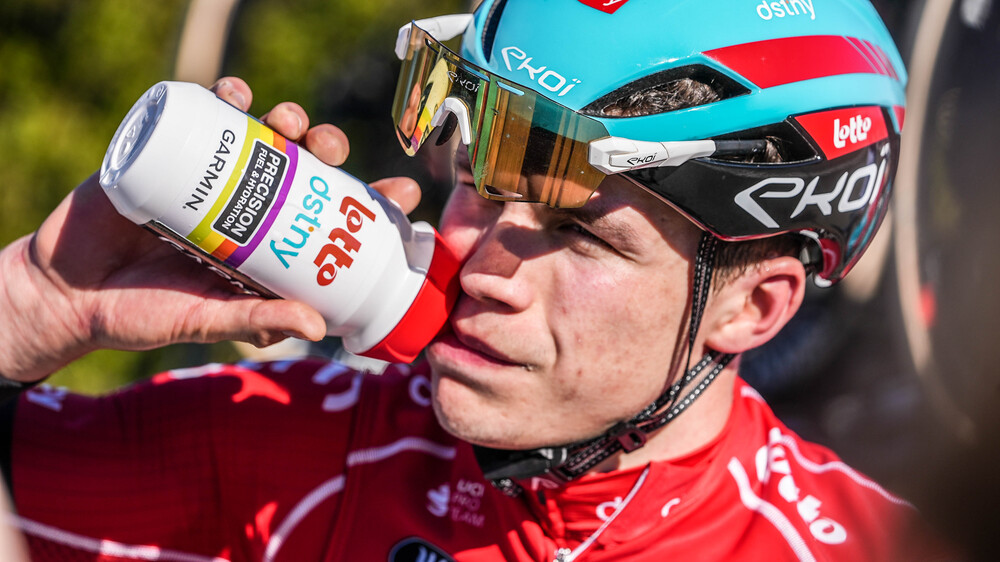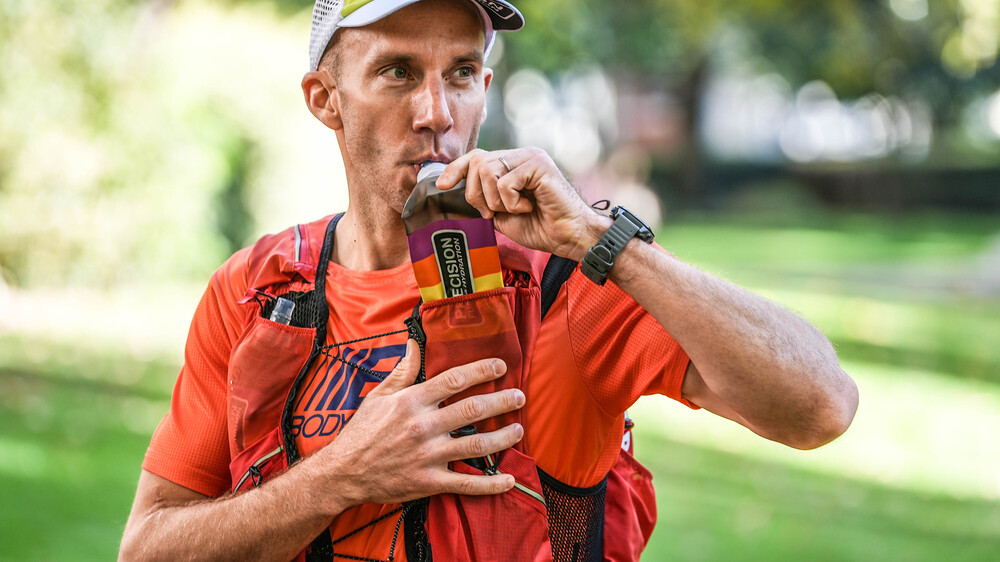It’s well known that athletes will usually - and probably should - finish hard training sessions and races in a somewhat dehydrated state.
Evolution has honed the human body to cope with temporary and modest levels of net water and salt loss during exercise. It anticipates the fact that fluids and electrolytes can be replenished with the food and drink that you consume during periods of rest post-exercise.
Homeostatic responses to mild dehydration are powerful and include feelings of thirst and a craving for salt. Those responses drive the consumption of water and electrolytes in quantities that should cancel out the majority of any deficit over the course of a few hours.
Homeostasis is an excellent regulator of fluid and electrolyte levels in the body because, frankly, keeping fluid and sodium in equilibrium is essential to preserving life. As such, if you’ve got access to salts and fluids, you’ll naturally replenish what you need by simply responding to what your body is asking for.
So, if your body fluid losses aren’t significant and your recovery time between bouts of exercise is long enough, it’s highly unlikely that you’ll need to follow any specific protocols to ensure adequate rehydration takes place.

However, a strong case can be made for taking a more scientific and proactive approach to rapid rehydration when very high levels of uncorrected dehydration occur, or if there’s a requirement to train or compete again shortly after an initial bout of dehydrating exercise. Examples might include training twice in a single day, competing in a tournament of multiple rounds, or performing a weight-cut to achieve a certain body weight pre-competition.
In other words, if your recovery window is brief or the level of fluid loss is very high, you may benefit from having a rehydration plan in place so that you can go again and perform at your best repeatedly. Relying purely on instincts often won’t be good enough in these scenarios.
How not to rehydrate
When training full-time as a triathlete quite a few years ago, I was in the middle of a big training block and screwed myself up for a few days by getting very dehydrated.
For once, it was lovely and sunny in the UK and had been for several days. I’d been doing double workouts all week and set out late one afternoon for a longish, hilly trail run having already clocked three hours on the bike that morning.
I remember feeling a bit thirsty before starting, but thought ‘it’s only an hour’ (yes, I was in good shape but young and dumb) and set off without any fluids. I started to realise that all was not well about 25 minutes into the session. I was running over Hambledon Hill in North Dorset, fully exposed to the sun and sweating heavily. I sensed I was getting incredibly thirsty, light-headed and uncoordinated. Within a few minutes, my pace had slowed dramatically, and I was fantasising about a cold bottle of Evian water.
I rapidly became utterly obsessed with the desire to get a drink. I remember taking a good long look at the cattle water troughs on the hillside and seriously considering taking a slurp out of the greenish water. As I wasn’t far from a village, I opted to make a beeline for the nearest pub and plead for a free drink, this being well before Apple Pay or smartphones. Luckily the barman was in a charitable mood and poured me a pint of Dorset’s finest tap water.
By this point, my lips were very dry, and I didn’t feel well. I drained the pint faster than on any stag-do I’ve been on before or since and immediately went back for another. The second glass went down almost as quickly, and I took a couple of minutes to work my way through a third.
I left the pub to jog the two miles home but found that my stomach was swollen up, and I felt absolutely dreadful. I stopped running, decided to walk home and had a shower, struggling to reconcile the dual desires of needing to drink more to relieve my thirst, whilst desperately wanting to avoid adding to the uncomfortable, distended feeling in my stomach.
It took a couple of hours of lying on the sofa before I eventually started to feel a touch better and took myself off to bed. I then remember waking up later that night with a raging thirst and had to take the following day off training altogether because I felt so lousy. I spent the next day with an overwhelming craving for salty food. I returned to light training two days later but suffered from really sore and tight muscles. It took about four days for me to feel fully recovered after the incident.
Looking back, I strongly suspect that I’d initially suffered fluid (and electrolyte) depletion that had come on very gradually over a number of days preceding that run to the pub. That session marked the point where I tipped over the edge into a state of severe dehydration. It had been unseasonably hot, I had been training hard and, whilst I was largely drinking what I felt I needed to, I certainly wasn’t being proactive about fluid and electrolyte intake during or between sessions.
The episode taught me that dehydration is something that can creep up on you if you’re training frequently and not paying attention to it. It can then feel like it manifests ‘suddenly’ when you reach a critical level of fluid deficit. When it gets to that point, recovery becomes a multi-day process.
I also learned that downing a very large quantity of plain water in a short space of time isn’t an especially productive way to rapidly rehydrate either.
An ounce of prevention is worth a pound of cure.
Based on his quote from the mid-1700s, Benjamin Franklin understood that it’s usually better to prevent something negative from happening in the first place, rather than having to ‘cure’ it once it’s occurred.
This applies to dehydration. And so, ‘recovery hydration’ actually begins by starting a bout of exercise appropriately hydrated.
Then, aim to drink sufficient amounts during an activity (where feasible) to keep body mass losses small - usually within 2-3% of your normal baseline - as this will help to keep the deficit you need to replace afterwards in a short space of time afterwards at an achievable level.
3 ways to approach rehydration
Clearly, there may be times when circumstances either dictate or conspire in such a way that you end up more dehydrated than is optimal. There are also situations where, even if you don’t end an activity horribly dehydrated, you need to get up and perform well again shortly afterwards.
So, knowing ways to nail rapid rehydration to maximise its effectiveness can be helpful…
1. Replace ~150% of your fluid losses
There’s ample literature which suggests that in order to fully rehydrate after exercise you need to consume quite a bit more fluid than you’ve sweated out. This is because you won’t absorb and retain everything that you drink (some will be lost in urine for example) and you’ll potentially carry on sweating for a time after finishing.
Replacement of ~150% of your losses in the first 2-3 hours appears to be the ‘sweet spot’ that most credible scientists settle on as sensible. This means that if you end an activity 1kg / 32oz lighter than you started, it’ll take about 1.5 litres / 40oz of fluid intake to completely rehydrate (i.e. (1 litre = 1 kg / 32oz = 32oz).

Interestingly, when researchers tested 200% and higher amounts of fluid replacement, they found that urine output simply increased as well. So, there’s unlikely to be any point in going too crazy with the level of replenishment beyond 1.5x losses.
Being overly aggressive could actually even be counterproductive if it leads to dilution of sodium levels in the blood and a nasty condition known as hyponatremia.
One thing that it’s critical to note is that when needing to ingest relatively large amounts of fluid in a short period of time, plain water alone doesn’t really cut it…
2. Add (enough) sodium to your fluids
Sodium is the predominant electrolyte in blood plasma and performs a critical role in fluid absorption and retention of liquids you drink.
Within reason, the more sodium you put into a rehydration drink, the better your body will retain the fluid. Its presence helps maintain plasma sodium levels which leads to the kidneys feeling like they need to excrete less water to maintain blood sodium concentration where homeostasis needs it to be (135-145mmol/L).
Most regular sports drinks only contain about 400-500mg of sodium per litre. Whilst this might be just about adequate to replace low sweat sodium losses during shorter activities, it’s a long way below the levels required to maximise rehydration post-exercise.
A maximally effective rehydration mix will contain around 1,500mg of sodium per litre. This is the reason why we often recommend PH 1500 electrolytes as an ideal post-workout or post-race drink at times when your sweat losses have been high.

3. Add glucose
The 1970s medical journal, The Lancet, called Oral Rehydration Therapy (ORT) ‘The most important medical advance of the 20th century’.
ORT, in its most basic form, is a mixture of salt and sugar diluted into water. It can be used to treat the catastrophic forms of dehydration caused by sickness and diarrhoea that sadly kills many children and elderly people in developing countries every year.
It’s effective in rehydrating individuals because the sodium in the salt and glucose in the sugar combine in the gut to take advantage of a process called ‘sodium-glucose co-transport’. This essentially pulls more water through the wall of your gut into the bloodstream (and keeps it there) than drinking plain water alone can achieve.
When rapid rehydration is needed, it’s therefore helpful to either add glucose, or sugar, to your rehydration drink. Or, you can eat something sugary alongside a strong-sodium drink in order to achieve a similar effect.
PH 1500 drink mixes, which contain glucose and sodium, are arguably the most effective all-round rehydration product in the PF&H range for this reason.
What I should have done
In order to summarise what an optimal rehydration regime looks like for an athlete in the real world, it’s perhaps useful to use hindsight and break down how I might have done things differently during my big summer training block all those years ago:
- I could’ve weighed myself each morning to get a reliable baseline weight established and looked for any significant day-to-day changes or trends that might’ve indicated I was gradually becoming dehydrated. A drop of more than about 1.5% day-to-day would’ve been a red flag that my fluid (and possibly carb) intake wasn’t sufficient to replenish the previous day's efforts.
- I could’ve started all of my big training sessions properly hydrated by utilising a tested preloading routine. This would have also helped to ensure I was not beginning any session behind the curve when it came to fluid and electrolyte balance.
- I should’ve carried some fluids with me on that hour-long run in the heat. Whilst that wouldn’t have been strictly necessary to get me through the session itself, it would’ve started my ‘recovery rehydration’ process by limiting my losses in the first place.
- I should’ve weighed myself after my run session and taken in ~150% of my sweat losses by weight with equivalent amounts of PH 1500 in order to maximise fluid absorption and retention, which would’ve helped get me back to zero well ahead of the next day of training. This would’ve worked way better than just downing three pints of lukewarm tap water in the pub.
Hindsight is 20:20 but I do wish I’d known about all of this when I was racing and training more seriously. I think it would’ve resulted in more productive training at times when I was doing a high volume of work and the weather was hot.
Other rehydration strategies…
Beyond what’s outlined above, there is perhaps one other significant rapid rehydration strategy that can be useful to understand, even if it’s not as regularly applicable to athletes:
Intravenous Drips (IVs)
IVs are routinely used in hospitals and clinics to treat dehydration, fluid loss or electrolyte imbalance. Effectively, an IV bypasses your gut and puts a set volume of fluid and solutes directly into your bloodstream. I’ve had one administered at the finish line of a long-distance triathlon where the medical team diagnosed dehydration, and that’s not an entirely uncommon occurrence, especially at hot and humid races.
I spoke to kidney specialist and keen amateur endurance athlete, Dr Hunter Huston, to understand the circumstances where there might be a case for athletes to use an IV for rapid rehydration (other than at the request of a doctor at the finish line of an event), given that there is strong evidence that they’re used fairly routinely in some sports.
Here’s what Hunter had to say:
“Generally, I adhere to an old adage of “if the gut works, use it”. We can generally deliver much more fluid in a short span that way than through IV, but that’s not always the case.
“Medically, the decision to use IV isn’t so much based on the total volume deficit, but the manifestations of that deficit. Specifically, the possibility that organ perfusion may be in jeopardy. A quick survey can pretty well establish whether there may be a risk of poor perfusion or not. This would include light-headedness, especially with standing from sitting or sitting from lying down, things like skin turgor, dry mouth, the things we tend to think of when asking about volume depletion.
“Objectively, low blood pressure, high heart rate, and a chem panel can be used to guide whether someone is really in trouble or not. If someone is coming into a medical tent or off the field in such a state, they’ll likely get some IV fluids to restore perfusion. In cases where there’s concern that the gut may not work effectively (think vomiting, diarrhea, inability to drink for any number of reasons), there is much more support for using IV fluids.
“In the non-medical setting, there’s little support for using IV fluids in general.
“There’s been some in vogue tendencies to do it with the thought that hyperhydrating will somehow offer benefit, though this is often quite the opposite when the heart accelerates and that fluid has nowhere to go but into the lungs. That’s not to say that one should knowingly step onto the field dry, but rather there’s not really a need to use IV to overfill the system.”
So it seems that the cases for using IVs for rapid rehydration are likely to be very limited and only applicable when oral rehydration isn’t possible and it’s deemed medically advisable to do so.
Can beer rehydrate you?!
Lastly, and just because I know you’re dying to know the answer to this one; how good, bad or indifferent is drinking a post-training beer from a rapid rehydration point of view? (Or in other words, would I have been better off begging the pub landlord for a pint of ale rather than water when I staggered off Hambledon Hill).
Well, this has been the subject of rigorous scientific research. And the consensus seems to be that whilst a single beer is no better than any other low-sodium drink in terms of fluid retention post-exercise, it’s not really any worse either. So, as long as you stick to just one drink (any more and the diuretic effect of the alcohol starts to make you pee more) and choose a 2-3% lager rather than a 7% hipster IPA, then rewarding yourself with a pint isn’t going to do much harm from a hydration standpoint.
Cheers!
